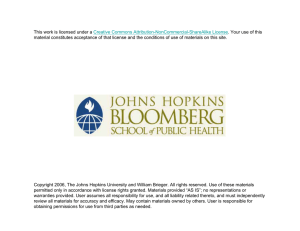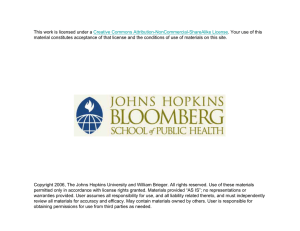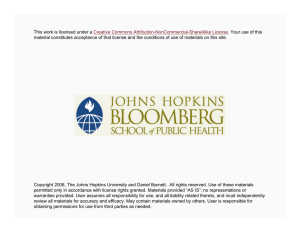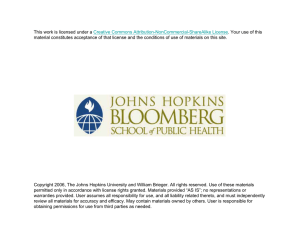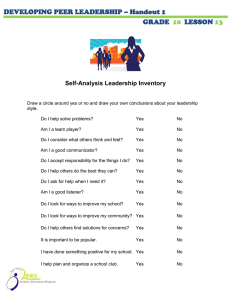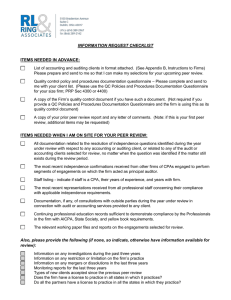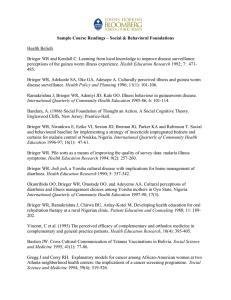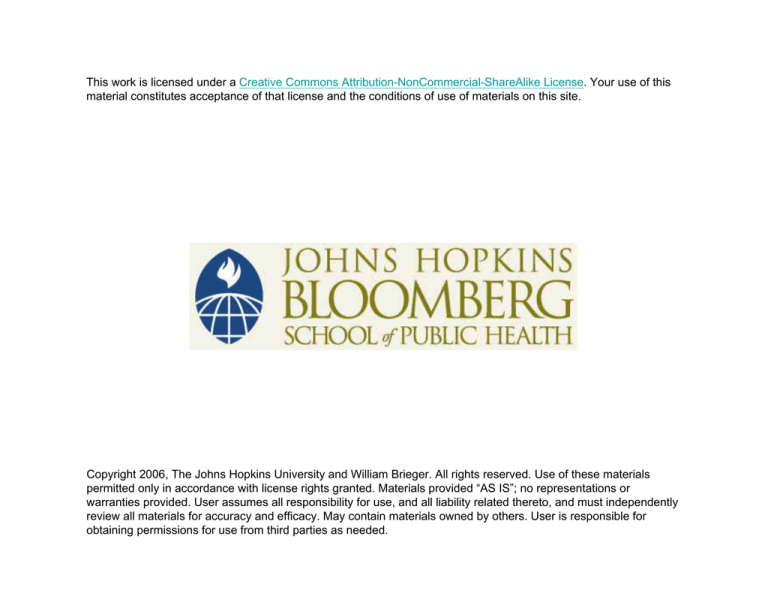
This work is licensed under a Creative Commons Attribution-NonCommercial-ShareAlike License. Your use of this
material constitutes acceptance of that license and the conditions of use of materials on this site.
Copyright 2006, The Johns Hopkins University and William Brieger. All rights reserved. Use of these materials
permitted only in accordance with license rights granted. Materials provided “AS IS”; no representations or
warranties provided. User assumes all responsibility for use, and all liability related thereto, and must independently
review all materials for accuracy and efficacy. May contain materials owned by others. User is responsible for
obtaining permissions for use from third parties as needed.
Social Networks
William R. Brieger, MPH, CHES, DrPH
Johns Hopkins University
1
Structure of a Network
Ù Density
– Connections or linkages within
Ù Size
– Number of direct contacts
Ù Range
– Extent, heterogeneity
Ù Intensity
– Emotional closeness, focal person
2
Network Characteristics
Influence Diffusion of Ideas, Behaviors, Even Diseases
Ù Density
– HIGH density: Many connections—
easier flow of innovations
– LOW density: Few connections—
slower or more difficult flow
Continued
3
4
Network Characteristics
Influence Diffusion of Ideas, Behaviors, Even Diseases
Ù Range
– HIGH range: Variety of different
members; greater opportunity for
new ideas to enter network; greater
influence in terms of community
change; as those members will
themselves have a variety of
networks
Continued
5
Network Characteristics
Influence Diffusion of Ideas, Behaviors, Even Diseases
– LOW range: Members more
homogeneous; fewer points where
new ideas can enter network
6
7
Youth Who Drink Alcohol
Friends
36%
Fathers
26%
Self
17%
Acquaintance
Brothers
6%
Mothers
9%
6%
Social contacts as sources
8
Rural to Urban Migration
Rural
Dweller becomes
Urban
Visitor
Social events
Family
Business
Friends
9
Urban to Rural (And Others)
In the community
Polygamy
Boy/Girl Friends
Divorcees
Commercial
Sex Workers
Drivers
Farm
Laborers
Lagos Returnees
10
Intervention Can Build
on Group Support
Training village health workers
11
Courtesy of the Hesperian Foundation: http://www.hesperian.org.
12
Network of Learning
Ù Village health workers become a social
network during training
Ù They reach out to other networks in
which they are members to share
knowledge and skills
13
Youth Groups Help Community
El Progresso, Honduras
14
Self-Help Among Diabetic Patients
Diabetic club
Ù Members provide
emotional support
when family members
reject someone
Ù They teach each other
skills and provide
encouragement to
enhance self-efficacy
Ù As a group, they
negotiate with medicine
shops for lower prices 15
Mother’s clubs for child health
16
Peer education builds on social support/networks
17
Peer education
programs are based on
theory and
assumptions that
young people can
communicate among
themselves better
18
Social Network Differences
Influence Peer Education Effects
Ù In-school networks
– Captive audience
– Well defined groups like classes
– Structured opportunities to interact
Continued
19
Social Network Differences
Influence Peer Education Effects
Ù Out-of-school networks
– Small networks—e.g. 6 apprentices
in a workshop
– Overall populations larger, more
diverse
20
21
Theoretical Bases
For Peer Education
Ù Building knowledge
– Information flows more freely
among peers
Ù Perception of risk
– Risk perception closely linked with
emotional development stages
Continued
22
Theoretical Bases
For Peer Education
Ù Perception of norms
– Beliefs of whether the behavior is
acceptable, approved of by social
network
Continued
23
Theoretical Bases
For Peer Education
Ù Self-efficacy
– Enhanced through observational
learning, especially by observing
people in similar situations/similar
backgrounds
– Greater sense of identity with
people of similar background
24
Social support is often
needed to support
public health efforts like
immunization. Do family
members (who help
watch over other
children at home)
approve? ... etc
25
Networks Are Units of Identity
Ù People know to which network they
belong
Ù People belong to many networks
Continued
26
Networks Are Units of Identity
Ù Different networks may meet differing
needs for social support
– Emotional, appraisal, material, and
informational
– Networks mediate between the
individual and the larger community
Ù Networks collectively comprise the
fabric of the community
27
Network Analysis
Ù
Ù
Ù
Ù
Memberships
Connections
Sources of support
Define an individual’s coping strategy
28
Network Analysis
Ù Note
– Networks do not include social
services and service providers
– Networks serve as mediators
between these services and
individual group members
29
Memberships
Co-op/
union
Extended
family
Farmer
Religious
sect
Social
club
30
Different Groups,
Different Support
Ù Union or co-op
– Material support
• Access to government fertilizers
as a group
• Loans, contributions
Continued
31
Different Groups,
Different Support
Ù Union or co-op
– Information support
• Sharing ideas about crop
production and availability of
agricultural inputs
– Appraisal support
• Feedback on production
methods, crop choices
Continued
32
Different Groups,
Different Support
Ù Social club
– Emotional support
• Attend each member’s social
events
• Come together for mourning
Continued
33
Different Groups,
Different Support
Ù Social club
– Material support
• Contribute financially to
ceremonies
• Loan each other money
– Appraisal support
• Feedback on performance of
social roles
34
Copyright 2005, The Johns Hopkins University and Bill Brieger. All rights reserved. Use of these materials permitted only in accordance with license rights granted.
Materials provided “AS IS”; no representations or warranties provided. User assumes all responsibility for use, and all liability related thereto, and must
independently review all materials for accuracy and efficacy. May contain materials owned by others. User is responsible for obtaining permissions for use from
third parties as needed.
35

